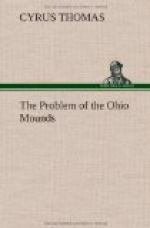The importance and bearing of this evidence does not stop with what has been stated, for it is so interlocked with other facts relating to the works of the “veritable mound-builders” as to leave no hiatus into which the theory of a lost race or a “Toltec occupation” can possibly be thrust. It forms an unbroken chain connecting the mound-builders and historical Indians which no sophistry or reasoning can break. Not only are these graves found in mounds of considerable size, but they are also connected with one of the most noted groups in the United States, namely, the one on Colonel Tumlin’s place, near Cartersville, Ga., known as the Etowah mounds, of which a full description will be found in the Fifth Annual Report of the Bureau of Ethnology.
In the smallest of the three large mounds of this group were found stone graves of precisely the type attributable, when found south of the Ohio, to the Shawnees. They were not in a situation where they could be ascribed to intrusive burials, but in the bottom layer of a comparatively large mound with a thick and undisturbed layer of hard-packed clay above them. It is also worthy of notice that the locality is intermediate between the principal seat of the Shawnees in the Cumberland Valley, and their extreme eastern outposts in northeastern Georgia, where both tradition and stone graves indicate their settlement. The tradition regarding this settlement has been given elsewhere. [Footnote: Am. Antiq, vol. 7, 1885, p. 133]
In these graves were found the remarkable figured copper plates and certain engraved shells, of which mention has been made by Mr. W. H. Holmes [Footnote: Science, vol. 3, 1884, pp. 436-438.] and by myself [Footnote: Ibid., pp. 779-785.] in Science. It is a singular corroboration of the theory here advanced that the only other similar copper plates were found at Lebanon, Tenn., by Prof. F. W. Putnam; in a stone grave in a mound at Mill Creek, southern Illinois, by Mr. Earle; in a stone grave in Jackson County, Ill., by Mr. Thing; in a mound of Madison County, Ill., by Mr. H. R. Howland; and in a small mound at Peoria, Ill., by Maj. J. W. Powell. All, except the specimens found by Professor Putnam and Mr. Howland, were secured by the Bureau of Ethnology, and are now in the National Museum.
There can be but little doubt that the specimens obtained from simple stone graves by Professor Putnam and Mr. Thing are to be attributed to Indian burials, but surely not to Indian manufacture.
We have, therefore, two unbroken chains connecting the Indians of historic times with the “veritable mound builders,” and the facts which form the links of these chains throw some additional light on the history of that mysterious people, the Shawnees.
It may be stated here that in the report relating to the claim of the Wabash Land Company [Footnote: American State Papers, Land Affairs, Appendix, p. 20.] is a statement giving a list of articles furnished the Indians, among which we notice nine ear wheels. These we suppose to be the same as the spool shaped ear ornaments found in stone graves and elsewhere.




